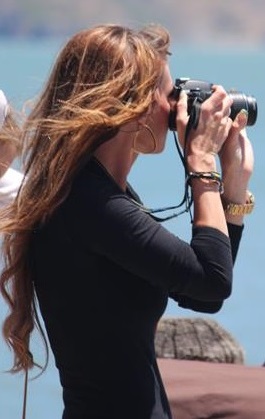
Want to be a Professional Wedding Photographer?
Some wedding photographers earn their entire income from photographing weddings.
For others it is only part of what they do.
This course is an excellent place to start. You may use the skills you develop to supplement your income; perhaps covering no more than a couple of weddings a month. Perhaps you already work in photography or a related field.
Wherever you allow this course to take you; the opportunities for wedding photography are strong, and will always be strong, so long as people keep getting married.
Course Content and Structure
This course contains 9 lessons; as outlined below:
- Introduction
- Nature and Scope of Wedding Photography
- Creating Romance
- Managing People
- Planning
- Developing a Checklist for Wedding Shots
- Brides Home, Grooms Home, General Shots, At the Ceremony, At the Reception, etc
- Digital Wedding Photography
- Equipment
- Lighting at Weddings; Rain, Sun, Overcast Weather
- Logistical Planning
- Key People to Liaise With
- Guidelines
- What Shots
- Listing Shots
- Preparation
- Understanding different Types of Ceremonies -Christian, Muslim, Buddhist, Jewish, etc
- Equipment
- Advantages and Disadvantages of Larger Format Cameras
- Digital Cameras
- Back Up Equipment
- Lenses
- Flashes and other Accessories
- Bags
- Battery Packs
- Tripods and Monopods
- Style Options

- Photojournalism versus Classical
- The Traditional Poses
- Other Shots
- Photographic Composition and Posing
- Taking Flattering Photos
- Principles of Photo Composition; Unity, Balance, Proportion, Harmony, Contrast, Rhythm
- Qualities of the Subject; line, form, mass, space, texture, colour, patterns, tone, lines and paths.
- Camera Techniques to Assist with Composition; movement, depth of field or focus
- Basic Principles of Light
- Basic Camera Terms
- Equipment and Materials
- Filters, Lighting
- Composition
- Rule of Thirds
- Developing a Portrait Style
- Posing for Photos
- A Photo Essay
- Blurring Movement
- Panning
- Shooting the Wedding Ceremony
- Pre Wedding Shots
- Order of the Wedding
- Precision, Greeting, Statements of Intention, Exchange of Vows, Exchange of Rings etc
- Important Shots at a Ceremony
- Posed Photographs before a Reception
- Indoor Weddings
- Controlling Light
- Restrictions on Photography
- Outdoor Weddings
- Dealing with Strong Backlight
- Larger Wedding Parties
- Smaller Wedding Parties
- Video
- Shooting the Wedding Reception
- Scope and Nature of the Reception

- What and when to shoot at a Reception
- Guests
- Post Production
- Processing
- Batch Processing
- Fault Finding
- Digital Colour into Black and White
- Digital Duotone and Sepia Tones
- Filters and Image Processing
- Special Effects
- Compositing
- Presentation of photos, etc
- Business & Marketing
- Selling yourself Establishing a Wedding Photo Business
- Devising a Business Plan
- Marketing
- Scheduling your Work
- Financial Management
- Insurance
- What to Charge
- Written Contracts
- Customer Satisfaction
- EQUIPMENT

This course can be undertaken successfully without sophisticated camera equipment, however you do need the use of a camera. An SLR camera is best but any camera will do. You can do this course using either a film or digital camera; or both.
If you use film, you will need to purchase a minimum of 5 rolls of film and have them developed. (Inexpensive proof prints are acceptable). All photos and written work submitted will be returned to you.
Aims
- Determine factors relevant to any particular wedding, that can impact upon the way in which a photographer will plan and conduct the shooting of photos for that wedding.
- Learn how to plan what to do, where and when on the wedding day.
- Select photographic equipment appropriate for use when photographing a wedding.
- Determine an appropriate style for wedding photographs, according to the needs of the client.
- Improving your photographic composition.
- Shoot a Wedding Ceremony
- Shoot a Wedding Reception
- Process and present wedding photos to the clients, in a variety of formats
- Successfully establish, market and manage a wedding photography business
HOW DO YOU HELP A CLIENT POSING FOR PHOTOGRAPHS
If your aim is to capture someone's personality, you must first get to know their personality. Observe your model, how they stand, walk, sit, react to other people, their facial expressions, their hand movements etc.
Character can be enhanced by the components you put into a photograph with the person you are shooting:
For general portraits:
- If they are a footballer, photograph them holding a football (perhaps this could work with the pre-wedding shots at the grooms house).
- If they are a scientist, photograph them in their lab coat (doesn’t generally go well with a wedding dress mind you).
- A business person may be photographed behind a desk.
You should also allow room for spontaneity and work with what’s around you. If you were taking photos of the couple on the beach when a scuba diver emerged from the water – why not get him in a shot? Remember that although your aim is to take beautiful portraits you are also there to record the events of the day.
A completely different type of portrait is when the photographer attempts to create an interesting picture, using a model, but not giving consideration to his/her character and personality. The total picture comes first rather than the person - you are photographing a person as part of a picture, not a picture of a person. If taking this approach, out of courtesy you should make sure your model knows your intentions (e.g. a man standing on top of a cliff with the ocean in the background).
- If the picture is basically just of the person, and not the surroundings, then the person should, as much as possible, fill the frame.
- If the surroundings are part of the portrait, then the person should be placed in the best position to complement the surroundings.
- Look through the viewfinder and study all parts of the photo before shooting.
- Learn the relationship between the viewfinder and the lens when using a non reflex camera.
- Learn to help your model relax, or appear relaxed. Try telling jokes.
- Try talking, giving reassurance of how things are going even if they are not going well.
- Don't try to get a smile from someone who finds it difficult. (A smile is reflected in the eyes as much as the mouth and even if the mouth smiles, it can look odd if the eyes don't also).
- If the muscles in the face are becoming tense, some facial exercises can relax the muscles and make a natural look easier to get (eg. breathe in, blow the cheeks up, then exhale - do this a few times) Licking the lips can also help achieve a more natural look.
- You may have to ask your subject to relax their jaw and slightly part their lips. Make sure they don’t relax it too much so they look like they are about to dribble.
- Eyes can loose their lively appearance while the model waits for a photo to be taken - this is difficult to explain but an easy problem to see if the photo didn't work out as you wanted. If a model is beginning to stare or look tired in the eyes, tell them to look away from the camera for a while, or to close the eyes for a while.
- Never try to direct a model to take up an uncomfortable or awkward pose.
- If you are photographing an old person with a much wrinkled face, and if those wrinkles are a part of his character and personality, then they should be shown (even emphasized) in the photograph, rather than hidden.
- Some people find it hard to smile naturally when asked; if this is so, are best photographed without a smile.
- For head and shoulders shots, the model is best to sit on a backless stool. A backed chair can easily become included in the picture, however it does tend to support the person and stop them slouching. Watch that this doesn't occur when using a stool.
WHAT NEXT?
Register to Study - Go to “It’s Easy to Enrol” box at the top of the page and you can enrol now.
or
Get Advice – Email us at info@acsedu.co.uk OR
Use our FREE COUNSELLING SERVICE to contact a tutor
CLICK TO CONTACT US